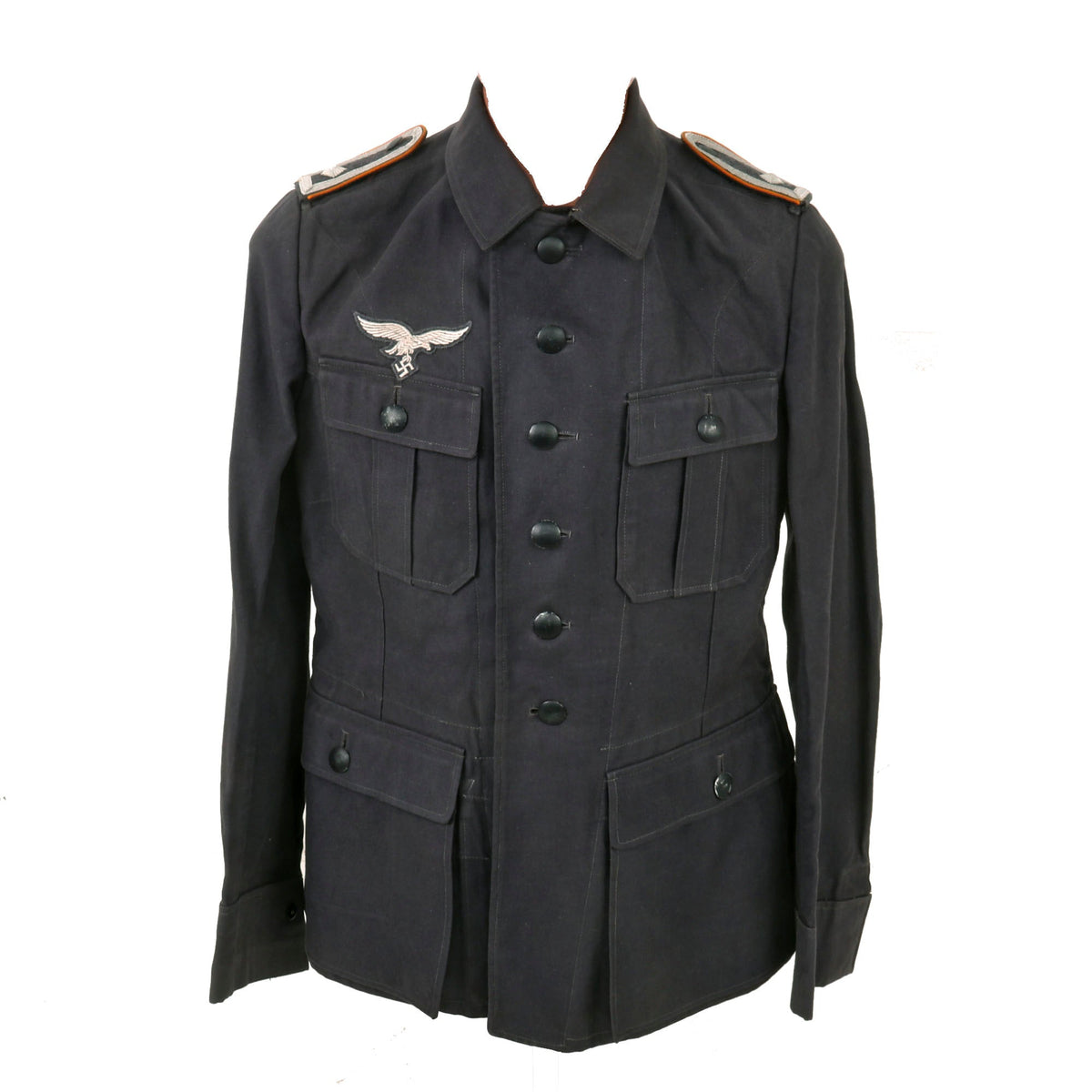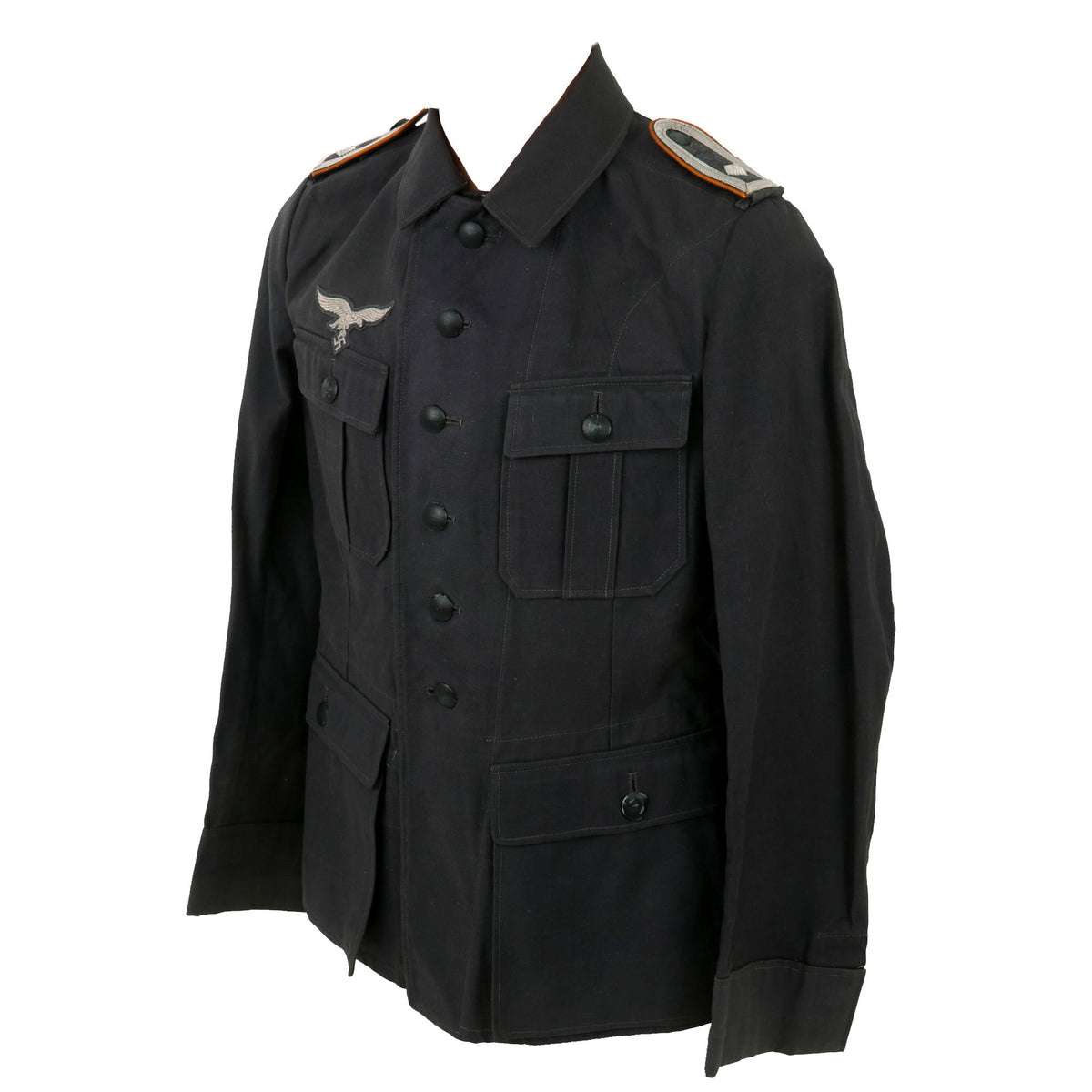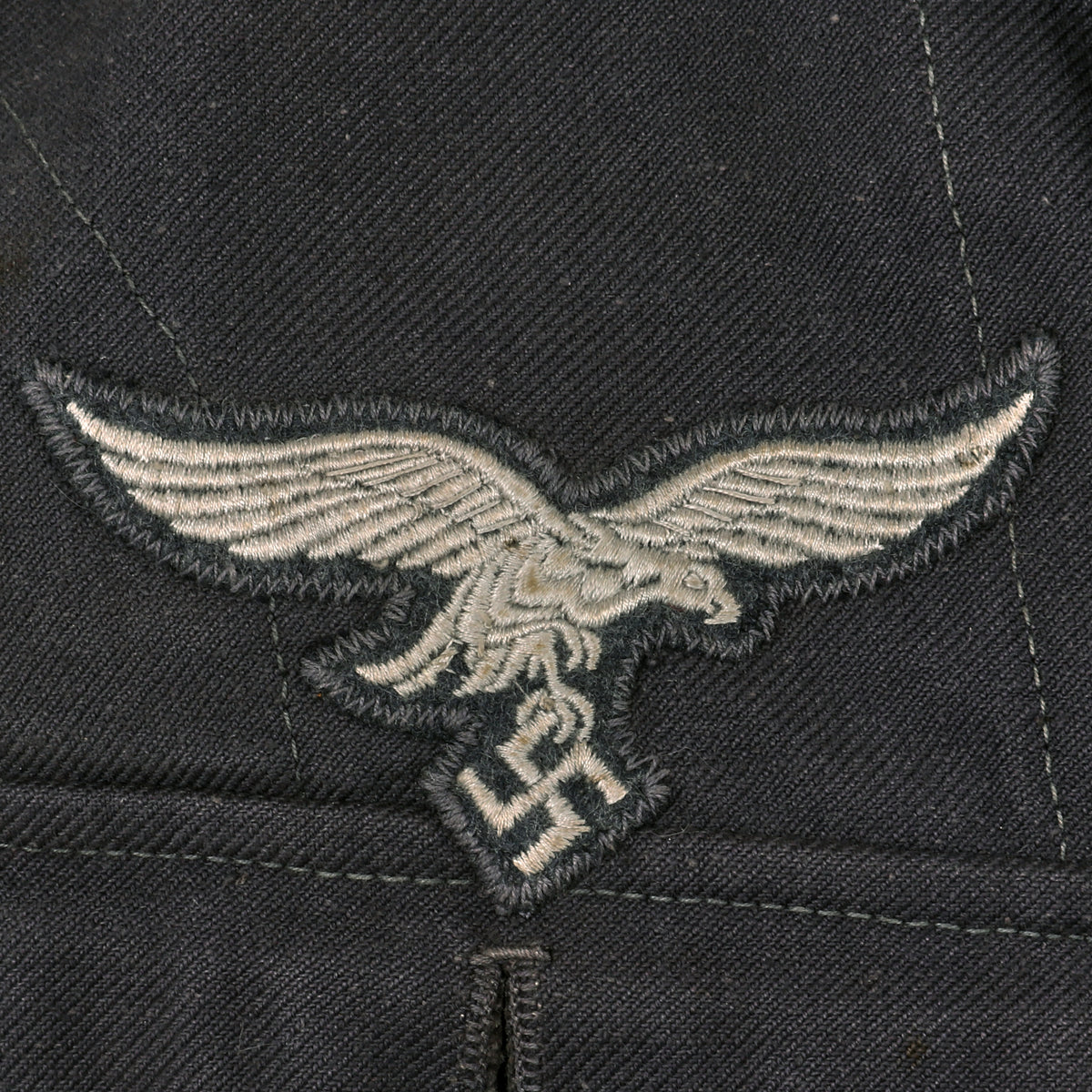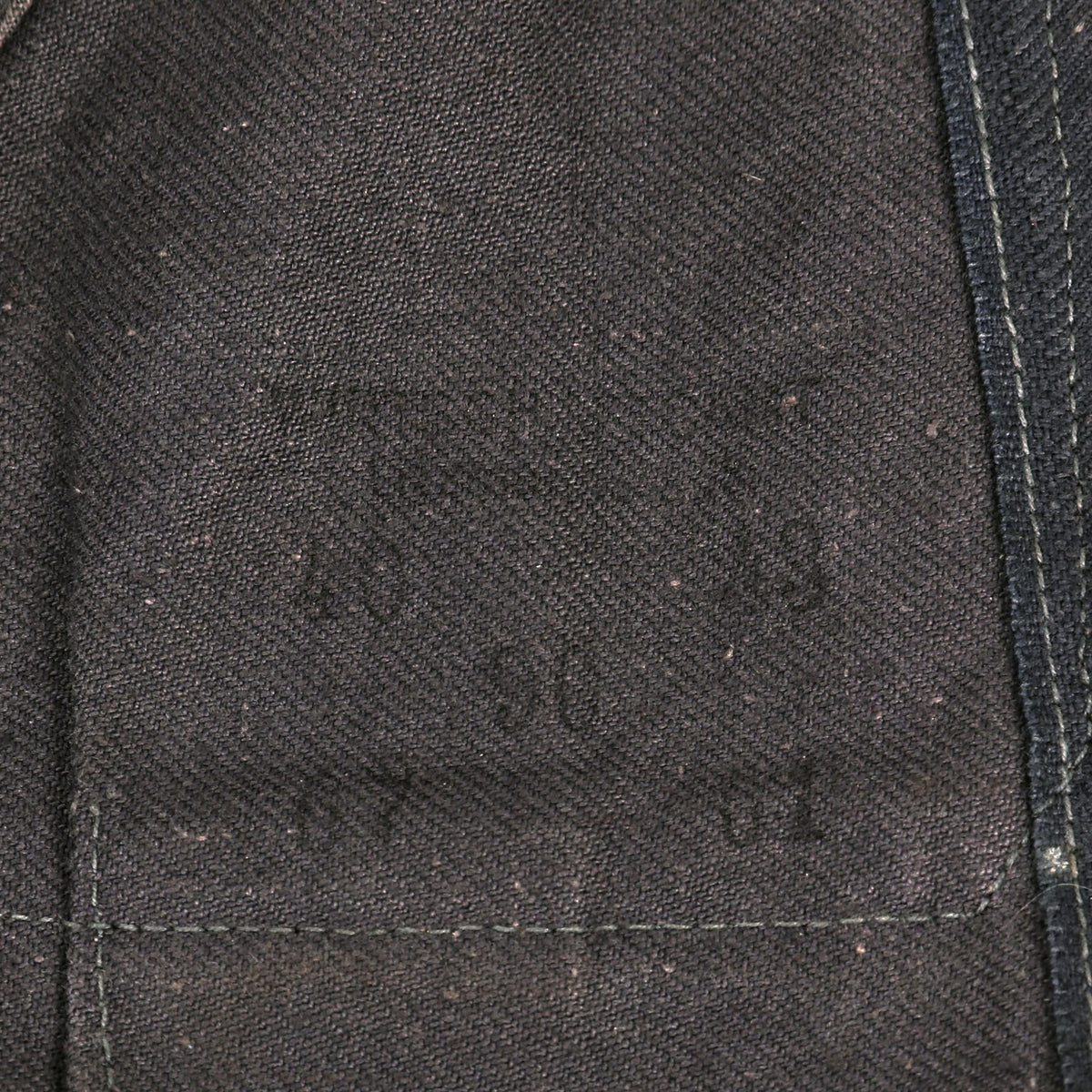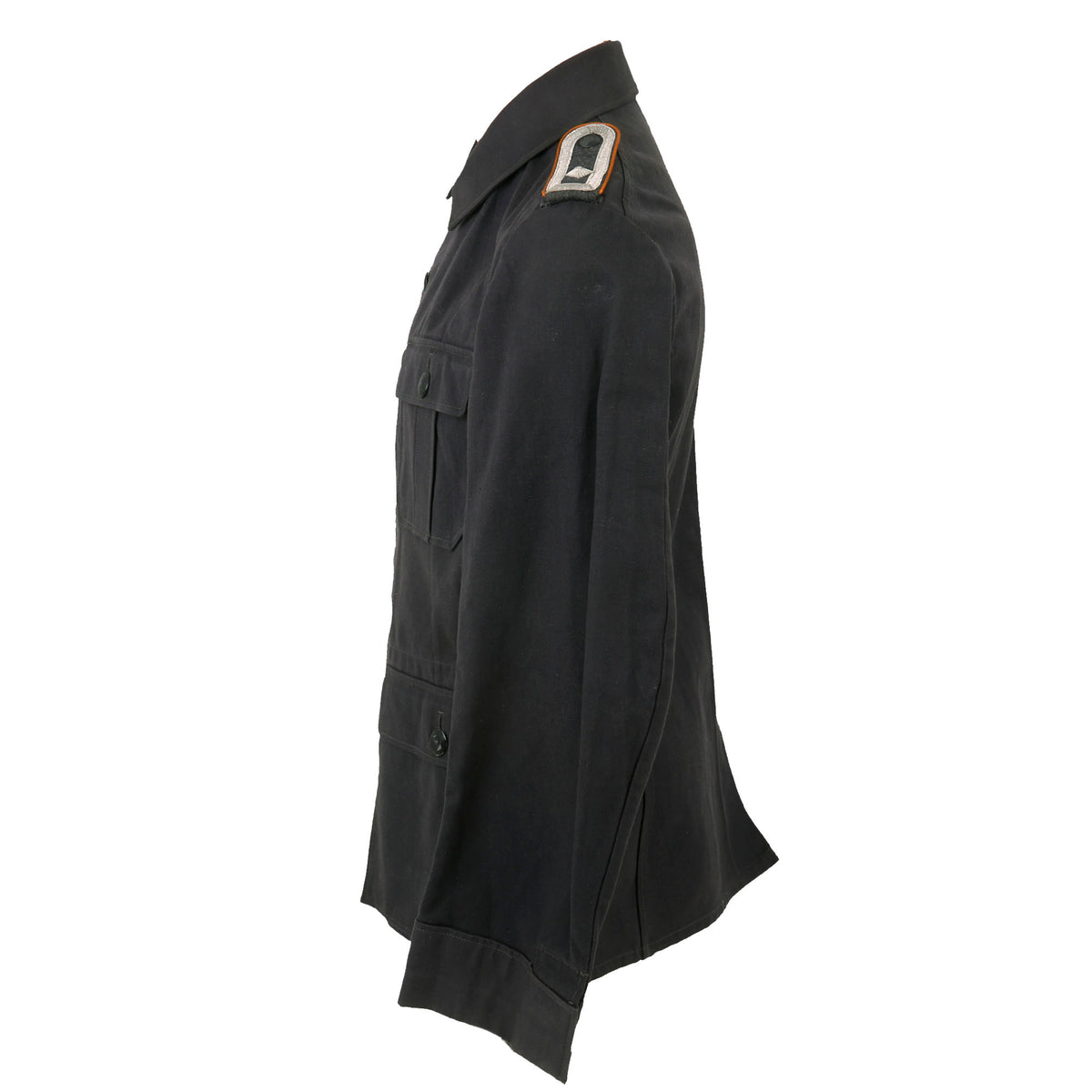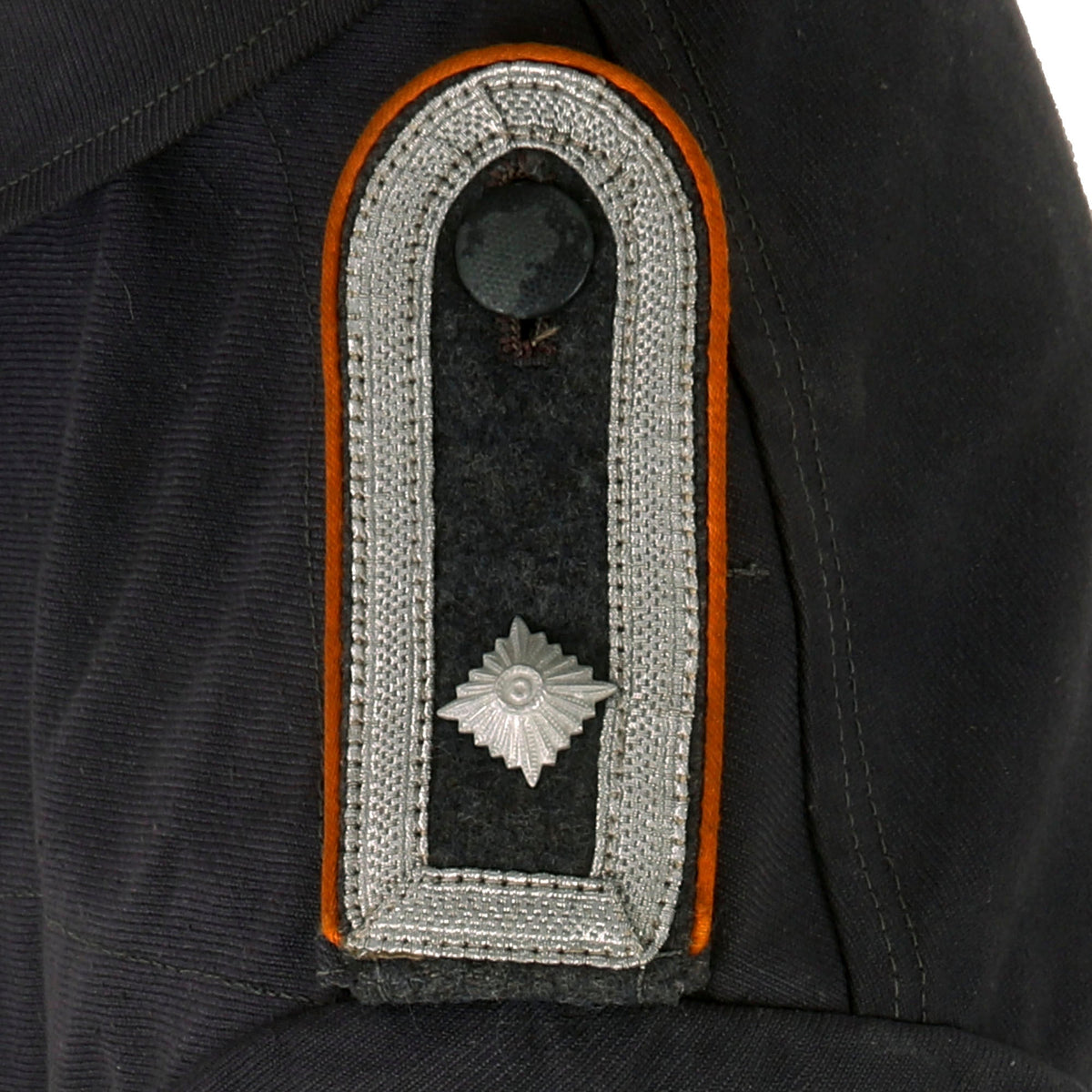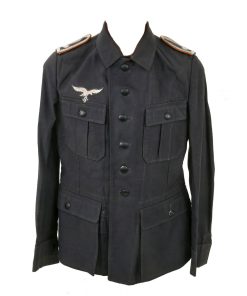Original Excellent German WWII Luftwaffe Flight Branch Feldwebel NCO HBT Blue Denim Field Service Tunic Original Items
$ 2.495,00 $ 623,75
Original Item: Only One Available. Just acquired from a private collection, this is an excellent condition Luftwaffe Unteroffiziere (NCO’s) Field Service Tunic, made from what feels like a denim or canvas material, very similar to the uniforms used during the North Africa Campaign. It is definitely of higher quality and weave than the later “Drillich” fabrics used, including the “reed green” HBT used by the Luftwaffe later in the wary. It is definitely intended to be a more durable version of the Feldbluse than the wool versions in use during the beginning of the war.
The front features 4 pockets with square flaps, each retained by a button. The breast pockets are pleated, while the waist pockets are not, as usually seen on earlier war produced examples. The front closure features 6 pebbled aluminum buttons painted with the correct Luftwaffe fliegerblau (flyer’s blue) color, along with a hook and loop collar fastener as well as a smaller button and strap. The buttons on this tunic are retained by round circlips from the rear, and all are non-magnetic, probably made from zinc. We did not see any maker markings on the reverse. The interior is not lined, and has some lighter blue reinforcements under the sleeves and for the belt hooks. The original first aid bandage pocket is intact, along with the closure button. There are original maker and size markings ink stamped on the interior, but they are quite hard to read due to the dark color of the fabric.
The tunic is adorned with the usual rank and branch insignia used on German Luftwaffe tunics. The attractive Luftwaffe breast eagle is the correct NCO embroidered type, and is very neatly hand stitched to the chest in a fashion typical of wartime German tailor work. The button-attached style Unteroffiziere Schulterklappen (NCO Shoulder Boards or Epaulettes) are piped in Goldgelb (Gold-Yellow), the correct Waffenfarbe (Corps Color) for Aviator troops such as pilots and ground personnel, as well as Fallschirmjäger (parachute troops). Inside the piping is a single row of 10mm NCO tress around the outside with a single “Pip” added, indicating the NCO rank of Feldwebel (Flight Sergeant).
Condition is truly excellent, and there is not much that could be improved upon with this tunic. There are just a few stitch pulls and minor wear on the buttons, most likely from storage and not from any type of service. They are zinc, and as the material oxidizes, it can easily cause flaking.
A very nice example in great shape, ready to display!
Approximate Measurements:
Collar to shoulder: 9″
Shoulder to sleeve: 27”
Shoulder to shoulder: 15”
Chest width: 18″
Waist width: 18″
Hip width: 23″
Front length: 30″
Most recruits previous to 1940 were issued a fatigue uniform (Drillichanzug) for basic training which they kept for work details, weapons cleaning and other duties likely to soil clothes. This was an unlined, insignia-less uniform made of linen or cotton herringbone twill (HBT) that typically had two buttonless patch pockets on the skirt; enlisted versions had a standing collar while NCO and officer versions had rise-and-fall collars. The fatigue uniform originally was undyed and therefore a color that ranged from white to oatmeal to cement grey. On 12 February 1940 the color was ordered changed to a bluish green called “reed-green.”
Since the heavy wool feldgrau uniform proved to be oppressively hot in summer weather, especially in southerly latitudes, soldiers took to wearing their lightweight green fatigue uniforms in the heat. In about 1942 the Army regularized the practice: depots began issuing an official hot-weather four-pocket field uniform of feldbluse cut but made of the same reed-green HBT material. For the enlisted Heer, these were usually worn with collar insignia and national eagle. NCOs would typically wear the summer uniform (Sommerfeldanzug) with appropriate rank on their shoulder boards, but the collar braid seen on the wool uniforms was typically absent. Two models were approved for use in the Army, the first that was designed after the M40 feldbluse and a later model that removed the front pocket pleats and pocket flap scallops similar to the M43. From 1943 a double-breasted version based on the Panzerjacke was made for vehicle and assault gun crews. SS units never had an official unique summer uniform, and while some used the Army versions, most used the earlier dyed work fatigues without insignia. While commissioned officers did have bespoke summer uniforms made, there was no regulation summer field uniform.
The Luftwaffe, the air force of the German military during the Third Reich, was established in 1935. Over the next 10 years, Luftwaffe troops wore a huge variety of uniforms. Enlisted men generally wore uniforms issued from military depots. Most enlisted soldiers had wool trousers and a short jacket with two internal lower pockets, called a Fliegerbluse, as well as a dressier 4-pocket tunic, the Tuchrock. Officers wore the same general uniform styles, but as officers had to supply their own uniforms, they usually wore tailor made versions. There were also myriad varieties of specialized uniforms worn by certain units or in specific situations, from the tuxedo-style “gala” formal wear uniform of the pre-war period, to the plain coveralls worn by crews of anti-aircraft cannons. There were work uniforms, tropical and summer uniforms, and camouflage clothing for airborne troops and other Luftwaffe soldiers in ground combat. Flight crews had their own specialized gear, including leather jackets and warm, electrically heated suits. Most but not all Luftwaffe uniform jackets bore the Luftwaffe emblem of a flying eagle holding a swas.
Fast Shipping with Professional Packaging
Thanks to our longstanding association with UPS FedEx DHL, and other major international carriers, we are able to provide a range of shipping options. Our warehouse staff is expertly trained and will wrap your products according to our exact and precise specifications. Prior to shipping, your goods will be thoroughly examined and securely secured. We ship to thousands clients each day across multiple countries. This shows how we're dedicated to be the largest retailer on the internet. Warehouses and distribution centres can be located throughout Europe as well as the USA.
Note: Orders with more than one item will be assigned a processing date depending on the item.
Before shipping before shipping, we'll conduct a thorough inspection of the items you have ordered. Today, the majority of orders will be delivered within 48 hours. The delivery time will be between 3-7 days.
Returns
The stock is dynamic and we cannot completely manage it because multiple stakeholders are involved, including our factory and warehouse. So the actual stock may alter at any time. It's possible that you may not receive your order once the order has been made.
Our policy is valid for a period of 30 days. If you don't receive the product within 30 days, we are not able to issue a refund or an exchange.
You can only return an item if it is unused and in the same state as the day you received it. You must have the item in its original packaging.
Related products
Uncategorized
Uncategorized
Uncategorized
Uncategorized
Uncategorized
Uncategorized
Uncategorized
Uncategorized
Uncategorized
Uncategorized
Uncategorized
Uncategorized
Uncategorized
Uncategorized
Uncategorized
Armoured Fighting Vehicles of the World: AFVs of World War One (Hardcover Book) New Made Items
Uncategorized
Australian WWII Owen MK1 Machine Carbine SMG Custom Fabricated Replica with Sling Original Items
Uncategorized
Angolan Rebel 1970s era 60mm Inert Display Mortar from Angolan Civil War Original Items
Uncategorized
